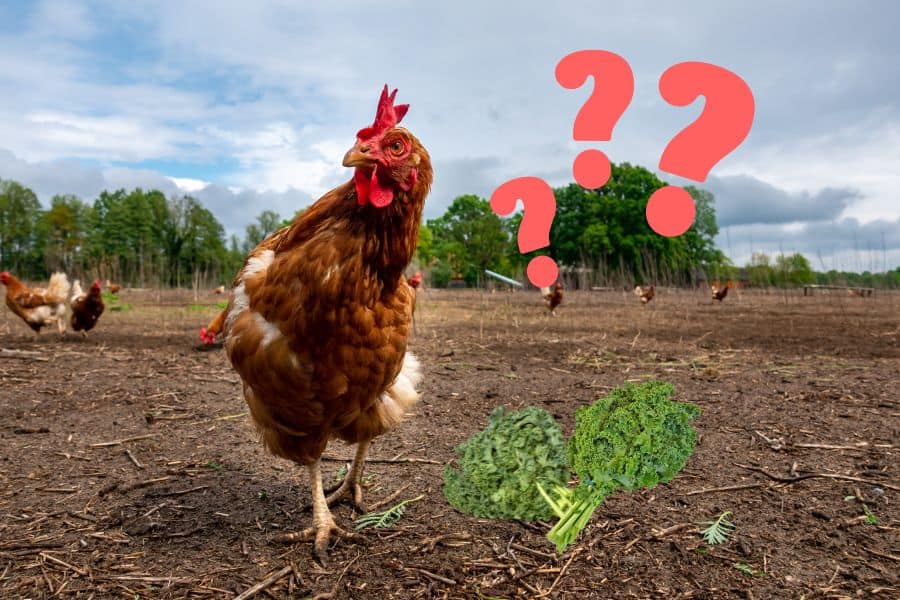Did you know that chickens are omnivores? If not, then you will be pleased to know that chickens can pretty much eat everything, from vegetables to fruits and grains to table scraps. So it is easy to raise them in your backyard.
Generally, most people who raise chickens use high-quality chicken feed as their primary source of nutrition. However, vegetables are also an excellent nutrition source for health reasons.
A leafy green vegetable many poultry owners consider for chicken food is kale. It is a superfood rich in vitamins and other nutrients, and according to experts, chickens can eat kale with outstanding results.
But let’s dive deeper into everything about this vegetable and discover kale’s nutritional benefits and the essential tips for feeding kale to your chickens.
Can Chickens Eat Kale?
The short answer to the question is, yes, chickens can eat kale. In fact, kale can be a delicious addition to a chicken’s diet.
However, kale also has superior nutritional value because it houses some of the best nutritional content chickens need. Specifically, kale’s nutrients are excellent since they are easily absorbed by chickens, benefiting their health and development.
Is Kale Safe for Chickens?
Kale is delicious, nutritious, and safe for chickens to peck on. In fact, it is similar to other green leaves and doesn’t have any toxic substances or components, meaning it is safe for chickens and other avian animals to eat it.
However, sometimes dirt and residual pesticide remain on the kale leaves, especially the commercial-produced kales, which have the heaviest applications of pesticides. Therefore, it is essential to check and thoroughly wash the kale to remove all the inedible and toxic things on them.
Also, although kale is indeed a safe food supplement for chickens, you should be wary of overfeeding your chickens with kale. Specifically, while it’s a safe vegetable for chickens, by only feeding them with kale, you might cause micronutrient deficiency.
Can Chickens Eat Kale Stalks?
Another question often asked by poultry owners is whether chickens can eat kale stalks. And the answer is that, thankfully, all of the kale’s parts are edible, meaning you can feel the kale to your chickens without leaving any waste.
However, as we will see later on, there are various types of kale, and have different stalks and stems. So, some may be deemed inedible for chickens or chicks to eat.
Is Kale Good for Chickens
Kale is a cruciferous vegetable like broccoli, cauliflower, cabbage, Brussels sprouts, and collard greens. And as already mentioned, kale is one of the most nutrient-dense vegetables. But it is also low in calories, making it a healthy nourishment source for chickens.
Specifically, kale is very high in antioxidants, vitamins, and other minerals that can fight off many significant diseases, lower blood pressure, and prevent sickness.
Let’s see in detail all the health benefits kale provides to chickens.
Antioxidants
Generally, antioxidants help the body fight oxidative damage from free radicals, which cause aging and other health complications.
Kale houses rich antioxidant compounds like beta carotene, flavonoids, and polyphenols, which promote health by lowering blood pressure and the risk of cancer, muscle inflammation, and heart-related diseases.
Furthermore, these antioxidants are essential for the chickens’ development and growth, as well as improving their metabolism.
Vitamin C
Vitamin C is an essential water-soluble compound with a significant role in the body’s cells. For instance, it supports collagen synthesis.
Additionally, it has an essential role in the immune system’s healthy function by resisting bacteria and preventing infections.
So, kale is undoubtedly an excellent food source for your chickens to prevent health complications. In fact, interestingly, kale contains larger quantities of Vitamin C than spinach, so it is one of the best sources of vitamin C globally.
Vitamin K
Vitamin K is a vital nutrient for birds. It causes blood clotting by activating certain proteins that bind calcium.
Specifically, blood clotting is responsible for preventing excessive bleeding after an injury, which can be difficult to achieve since it is not present in many foods.
Therefore, kale is an essential food source for chickens to enjoy the great benefit of vitamin K.
Fiber
Fiber is the second highest nutrient in quantity in kale. Generally, fiber helps control constipation and supports healthy and regular digestion.
So, kale helps chickens regulate bowel movements. Similarly, fiber reduces water retention. Hence, it is essential for chickens that rely on excreta as their means of body waste.
Useful Minerals
Kale is rich in minerals such as potassium, magnesium, calcium, and others, which add many beneficial elements to the vegetable.
Potassium maintains electrical gradients within the body’s cells and helps reduce the risk of heart disease.
Magnesium protects and prevents certain chronic diseases and improves the chickens’ immune system.
Calcium is essential in maintaining healthy bone development and plays a crucial role in cellular functions.
So, overall, when your chickens eat kale, they will reap many health benefits.
Lower Cholesterol
A significant characteristic of kale is its ability to lower the buildup of cholesterol in the body.
Cholesterol forms bile acids, which are released into the chicken’s digestive system and digest fatty foods.
One way to prevent this is through kale which contains bile acid sequestrants, which bind bile acids in the gut to prevent reabsorption.
So, undoubtedly, kale can reduce cholesterol drastically in the body, as well as the risk of heart disease.
Eye Support and Health
Kale contains zeaxanthin and lutein, helping lower the risk of macular degeneration and supporting eye health.
Also, it is rich in beta-carotene, Vitamins C and E, and zinc, which also support eye health and minimize the risk of blindness.
Types of Kale for Chickens
Like other vegetables and fruits, kale’s form, shape, size, thickness, and color can vary depending on the region. Still, all have the same nutritional value.
However, a thing you need to consider when choosing kale as your chickens’ food is its size and its stalk.
So let’s see below the types of kale that chickens can eat.
Curly Kale
Curly kale is the most common, and you can easily find it in a grocery store or plant and harvest it in your backyard and garden. It comes in purple or green color and is slightly curly in appearance.
Often, curly kale leaves are tough, but when fresh, they can easily be chopped and eaten by chickens. Stalks of young curly kale have tolerable toughness, and chickens can peck at it fearlessly.
Curly kale is known for its bitter, tangy taste and can be eaten cooked, raw, sauteed, or boiled. Also, curly kale is high in potassium, vitamin B6, and other antioxidants.
Redbor Kale
Redbor kale has a distinctive deep red and maroon color and veiny stalks that run straight across the leaf. In fact, from afar, you can mistake it for an actual stemming branch of a tree.
Redbor kale has a mild cabbage-like flavor and crisp texture, which the chickens can eat without worries. However, redbor kale features woody stalks that are not suitable for a raw kale diet for chickens.
Additionally, redbor is one of the most beautiful types of vegetables, so if you are planning to harvest it for your chickens or cooking, it will look stunning in your garden.
Baby Kale
Baby kale is another common kale type easily attainable from the grocery store. In fact, usually, it comes pre-packaged or with other salad greens.
Since it is incredibly tender with soft stems, it can be eaten raw or cooked. Also, the leaves are smaller and thinner in texture, so your chickens won’t have any issues pecking on them.
Dinosaur Kale
Dinosaur kale has a bluish-green appearance with long, thin, and slightly wrinkled leaves. However, their texture is firm and maintains their structure after cooking.
All parts of the leaf are safe and edible for your chickens. Feed it to them cooked or raw, but be aware that their stems are wood-tough, like tree twigs and branches, making them inedible.
Lastly, its taste is sweeter compared to other kale types.
Red Russian Kale
The red Russian kale has flat, reddish leaves resembling oak leaves and slightly deep purplish-green stalks.
Generally, red Russian kale is larger compared to other kale. That’s why it has a tough, fibrous, and woody stem, which chickens are unable to peck.
It has a mild peppery flavor, but your chickens will surely love its taste and benefit from its nutritional value.
Related: Can Chickens Eat Carrots?
Feeding Your Chickens Kale
As seen above, kale is a superfood that can benefit your chickens in many ways. Also, as indicated, kale comes in many forms, so you might wonder if all can be eaten in the same way. Read below everything you need to know about feeding your chickens kale.
How to Feed Kale to Your Chickens
Firstly, it is necessary to wash the leaves well to remove possible traces of pesticides and dirt.
Then, chop the leaves into tiny pieces, and then if you prefer, you can mix them with other veggies like a salad.
After washing and chopping, kale can be served either raw or cooked. However, keep in mind that cooking kale removes many of its valuable nutrients.
For better digestion, it is suggested to scrunch up the leaves on your hands. Or suspend leaves inside the coop to keep the chicken fed, as well as occupied if they are not outside free-ranging.
How Much Kale You Should Feed Your Chicken
Even though kale is a nutritious food source, as indicated before, chickens are omnivorous birds, and their diet requires various vegetables, fruits, and protein sources for optimal health. For instance, grubs and insects are also an important food source.
Therefore, it is essential to first feed your chickens with their regular feed before introducing and giving treats such as kale. Specifically, you can offer kale as a snack or mix it with other foods to create a nutritious and complete meal.
How Often Should You Feed Your Chickens Kale
Commonly, it is known that chickens can eat all day long. However, that is not always healthy. Usually, their regular feed comes with a guide to help you establish a feeding routine according to your chickens’ age, weight, and activity level.
When it comes to kale, generally, you should offer it to chickens about two to four times a week to ensure they obtain more nutritional variety while not becoming too fond of it or going off it altogether.
Conclusion
Can chickens eat kale? Yes, absolutely! But although kale is a healthy treat, it is also essential to feed your chickens other different types of food sources and to maintain a regular feeding routine with their high-quality chicken feed.
Nevertheless, kale is a vegetable providing many health benefits, such as antioxidants, vitamins, calcium, and fiber, so it is an excellent snack choice for a healthy, active lifestyle for your flock.


